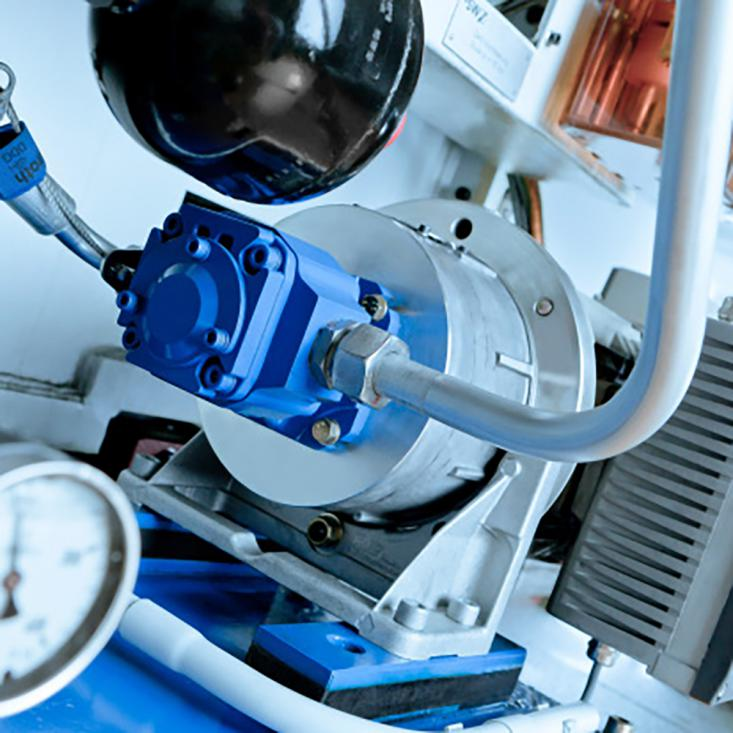1. Hydraulic Pump
- Function: The hydraulic pump is essential for creating the flow of hydraulic fluid under pressure. It transforms mechanical energy into hydraulic energy by drawing fluid from the reservoir and forcing it through the system.
- Types: There are several types of hydraulic pumps, including gear pumps, vane pumps, and piston pumps. Each type has different characteristics suitable for various applications, such as varying pressure and flow requirements.
2. Reservoir/Tank
- Function: The reservoir stores the hydraulic fluid and serves multiple purposes. It provides a supply of fluid to the pump, helps in cooling the fluid, and allows particles and contaminants to settle out of the fluid.
- Design: Reservoirs are designed to accommodate expansion and contraction of the fluid due to temperature changes. They often include sight glasses or level indicators to monitor fluid levels.
3. Hydraulic Fluid
- Function: The hydraulic fluid transmits energy throughout the hydraulic system. Its primary role is to deliver power from the pump to the actuators and other components.
- Properties: The fluid should have specific properties, including incompressibility, lubricating ability, and resistance to temperature changes. Common types include mineral oils and water-based fluids.
4. Filters
- Function: Filters are used to remove contaminants and particles from the hydraulic fluid. Contaminants can cause wear and tear on components, reduce efficiency, and lead to system failures.
- Types: Filters can be located at various points in the system, including the suction line (to protect the pump) and the return line (to keep contaminants from re-entering the system).
5. Pressure Relief Valve
- Function: This valve protects the hydraulic system from excessive pressure, which could damage components or lead to system failure. It regulates the maximum pressure by diverting excess fluid away from the system.
- Operation: The valve is typically set to open at a predetermined pressure. When the pressure exceeds this threshold, the valve opens, allowing fluid to flow back to the reservoir or another safe path.
6. Control Valves
- Function: Control valves direct the flow of hydraulic fluid to different parts of the system. They control the speed, direction, and force of hydraulic actuators.
- Types: There are manual control valves, which are operated by hand, and hydraulic control valves, which are controlled electronically or pneumatically. Directional control valves, pressure control valves, and flow control valves are common types.
7. Accumulator
- Function: An accumulator stores hydraulic energy by compressing gas or storing fluid under pressure. It helps to stabilize system pressure, absorb shocks, and provide a reserve of energy for peak demands or emergency situations.
- Types: Accumulators can be bladder-type, piston-type, or diaphragm-type, each with specific uses based on the system’s requirements.
8. Cooling System
- Function: Hydraulic fluid can become very hot due to the mechanical work and friction in the system. The cooling system helps maintain the fluid at an optimal temperature to prevent overheating, which can degrade fluid properties and damage components.
- Components: Cooling systems often include air-cooled or water-cooled heat exchanges that dissipate heat from the fluid to the environment.
### Detailed Operation of a Hydraulic Power Unit
1. Power Generation
- The process begins when the HPU’s motor, usually an electric motor or an engine, activates the hydraulic pump. The motor converts electrical or mechanical energy into rotational energy, which drives the pump.
2. Fluid Pressurization
- The hydraulic pump draws hydraulic fluid from the reservoir and pushes it through the system. The pump’s design determines the flow rate and pressure of the fluid. As the fluid is pressurized, it creates the necessary force to operate hydraulic actuators.
3. Fluid Distribution
- Pressurized hydraulic fluid flows through the system’s piping and hoses, guided by control valves. These valves manage the distribution of fluid to various parts of the system, such as hydraulic cylinders or motors, based on operational needs.
4. Actuator Operation
- Hydraulic actuators, such as cylinders or hydraulic motors, convert the hydraulic energy into mechanical energy. For example, in a hydraulic cylinder, the pressurized fluid moves a piston, which extends or retracts the cylinder, producing linear motion.
5. Pressure Regulation and Safety
- Throughout the system, pressure must be carefully regulated to prevent damage. The pressure relief valve continuously monitors the pressure levels and opens to release excess fluid if the pressure exceeds safe limits. This keeps the system operating within its designed parameters.
6. Fluid Return and Cooling
- After the fluid has performed its work, it returns to the reservoir through return lines. Here, it passes through filters to remove any contaminants before reaching the cooling system. The cooling system dissipates heat from the fluid, ensuring it remains within a safe temperature range before being recirculated to the pump.
7. System Maintenance
- Regular maintenance of the HPU includes checking fluid levels, monitoring filter conditions, and inspecting the pump and motor for wear. Ensuring that all components are functioning correctly is crucial for the reliable operation of the hydraulic system.
In summary, the Hydraulic Power Unit is the central component of a hydraulic system, converting mechanical energy into hydraulic energy and managing the flow, pressure, and temperature of hydraulic fluid. Its design and operation are critical for the efficient and safe performance of hydraulic machinery and systems.
HCIC is a professional hydraulic manufacturer, mainly engaged in hydraulic system design, manufacture, installation, transformation, commissioning and hydraulic components brand sales and technical services science 1998.During these years we develop our engineer team and quality control team,make sure providing safe and reliable products. We hope that our product can help to save your cost and improve your quality. For More details please email us "
[email protected]" or Google search "HCIC hydraulic"

